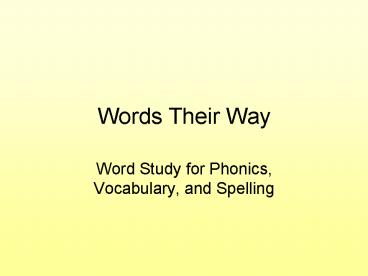Words Their Way - PowerPoint PPT Presentation
1 / 38
Title:
Words Their Way
Description:
Words Their Way Word Study for Phonics, Vocabulary, and Spelling * * * * * * * * * * * * * * * * Digraph sorts and a closer look at blends: Short and Long Vowels CVC ... – PowerPoint PPT presentation
Number of Views:819
Avg rating:3.0/5.0
Title: Words Their Way
1
Words Their Way
- Word Study for Phonics, Vocabulary, and Spelling
2
Word Sorts
- Instruction grounded in assessment of student
knowledge - Lessons designed around observation and
experience with sound and patterns
- Phonics
- Spelling
- Vocabulary
3
Brain research suggests that students gain
greater long term memory when they are
- Actively engaged
- Manipulating ideas and objects
- Using language to clarify and cement learning
- Interacting with peers in directed academic
conversations
4
Brain research suggests that students gain
greater long term memory when they are
- Investigating
- Testing hypothesis/making predictions
- Recording and constructing their own learning
5
- Mark Twain Shares
- If teaching were telling, wed all be so smart we
could hardly stand ourselves.
6
Using Word Sorts
- Word sorts demonstrate what students know
- Word sorts help students generalize what they
know to what they are learning
7
TO SIT BESIDE / Assess
- Look for what students know INDEPENDENT
- Using but confusing INSTRUCTIONAL
- Leave absent FRUSTRATIONAL
- TEACH TO WHAT IS USING BUT CONFUSING NOT WHAT IS
ABSENT
Donald Bear 2005
8
(No Transcript)
9
Word Study Lesson Plan Format
- Demonstrate introduce sort, using key
words or pictures - sort and check individually or with a
partner - reflect declare, compare, contrast
- extend activities to complete at seats, in
centers, or at home sorts, games, cut and paste,
expand word study notebook, make word charts
10
Sorting is the essential word study activity
- Hands-on
- Talking
- Compare/contrast
- Categorizing
- Thinking in action
- LETS SORT.
11
Open and Closed Sorts
- Closed sorts are based on criteria established by
the teacher - Open sorts are determined based on observations
and generalizations made by students - Words are intended to be sorted multiple times
- The faster the student sorts words, the greater
mastery he has over the sort
12
Types of Sorts
- Sound
- Pattern
- Meaning
- Word sorts
- Picture sorts
- No-peeking sorts
- Writing sorts
- Speed sorts
13
(No Transcript)
14
(No Transcript)
15
oo
ow
ou
16
Open Sort
17
?
Closed Sort Animals / Non-animals
18
?
19
10 Principles Of Word Study
- 1. Look For What Students Use But Confuse
(instructional level, miss 2 or more features) - 2. A Step Backward Is A Step Forward (begin where
students can have some success) - 3. Use Words Students Can Read (always introduce
words for recognition and understanding) - 4. Compare Words That Do with Words That
Dont (dont hide exceptions to the rules / use
the non-examples) - 5. Sort By Sounds and Sight (make comparisons)
20
10 Principles Of Word Study
- 6. Begin With Obvious Contrasts (cvc cvce)
- 7. Dont Hide Exceptions (oddballs, crazy
column, ?) - 8. Avoid Rules (guide to generalizations and
analogies) - 9. Work For Automaticity ( ex. - speed sorts)
- 10.Return To Meaningful Text (Word Hunts)
21
The Basis of Word Study
- Alphabetic represented by the relationship
between letters and sounds - Patterns identifies sounds that are spelled by
single letters and multiple letters - Meaning groups of letters can represent
meaning directly
22
Synchrony of Literacy Development
Alphabet Pattern
Meaning
Emergent Beginning Transitional Intermediate Advanced
PreK to middle of 1st K to middle of 2nd 1st to middle of 4th 3 - 8 5 - 12
Emergent Letter Name - Alphabetic Within Word Pattern Syllables Affixes Derivational Relations
Reading Stage Grade Range Spelling Stage
23
Words Their WayStages of Development
- Stage 1
- Emergent Spelling
- Emergent Reading
- PreK to middle of grade 1
24
Words Their WayStages of Development
- Stage 2
- Letter Name-Alphabetic Spelling
- Beginning Readers
- K to middle of grade 2
25
Words Their WayStages of Development
- Stage 3
- Within Word Pattern Spellers
- Transitional Readers
- Grade 1 to middle grade 4
26
Words Their WayStages of Development
- Stage 4
- Syllables and Affixes Spellers
- Intermediate Readers
- Grades 3 - 8
27
Words Their WayStages of Development
- Stage 5
- Derivational Relations
- Advanced Readers
- Grades 5 - 12
28
(No Transcript)
29
Animal Picture Sort
Bears
Dogs
Monkeys
30
Lay and Say.
31
Food, Clothes and Toys
32
Beginning Sounds b,m
33
Word Families
34
Digraph sorts and a closer look at blends
35
Short and Long VowelsCVC Patterns
36
Long Vowel Patterns
37
Sort Your Word Cards
38
Prefixes re, un
39
Apply To Meaningful Text
40
(No Transcript)































